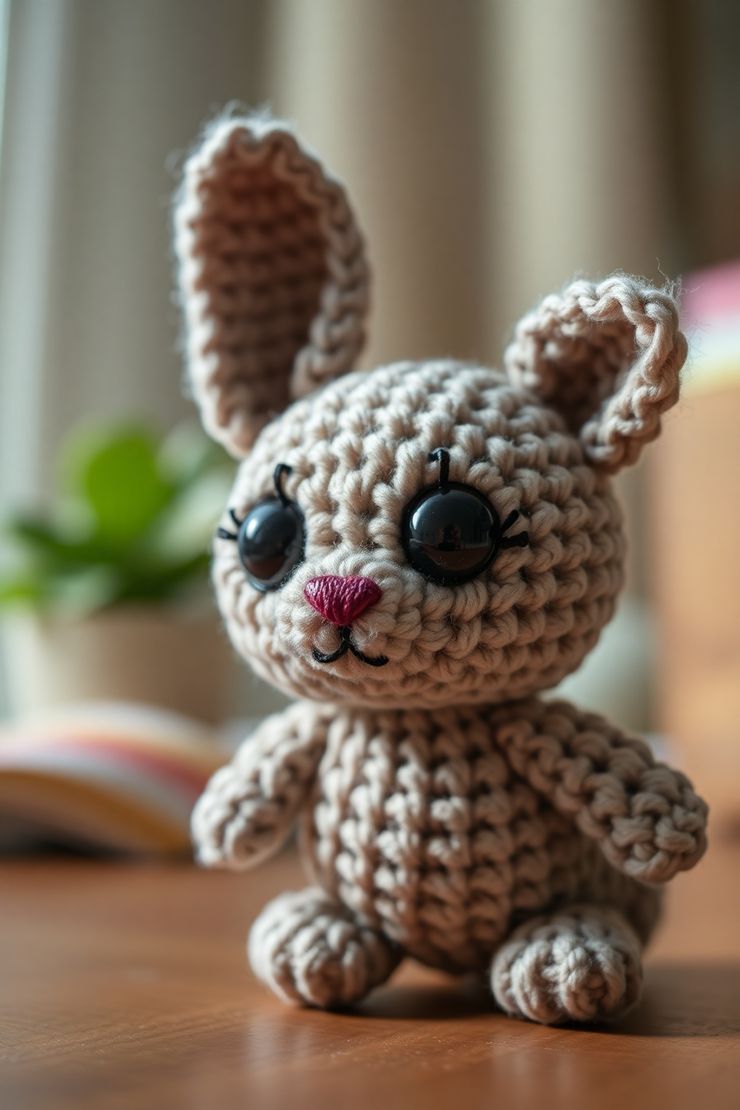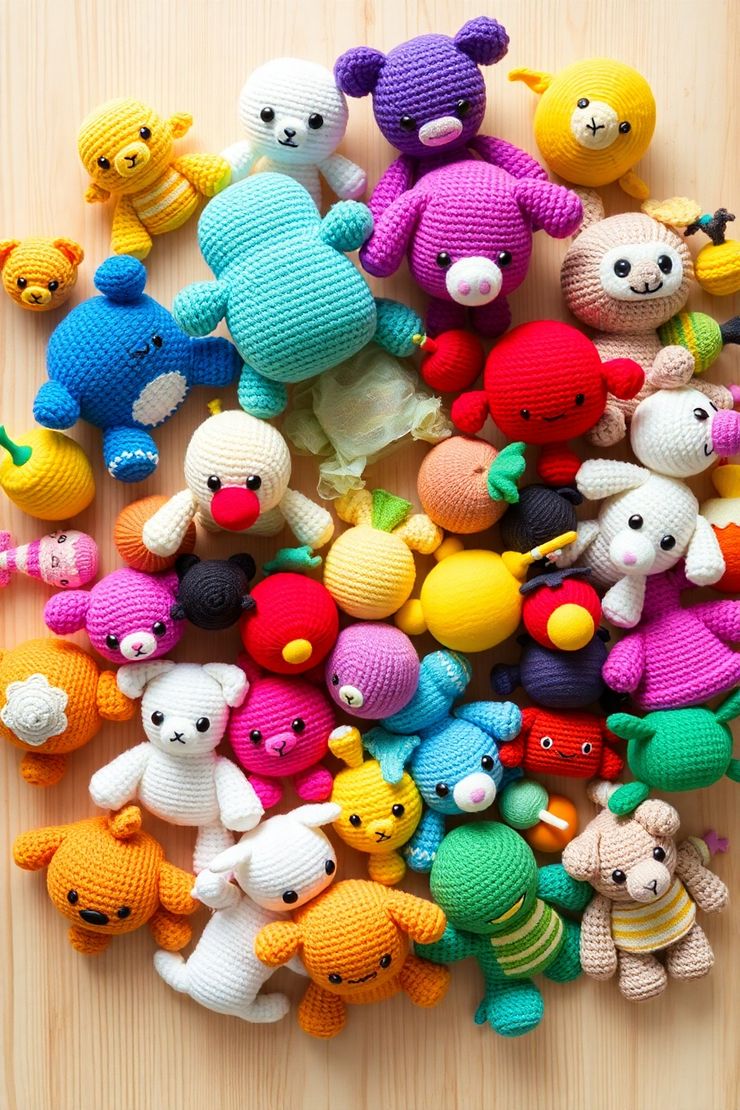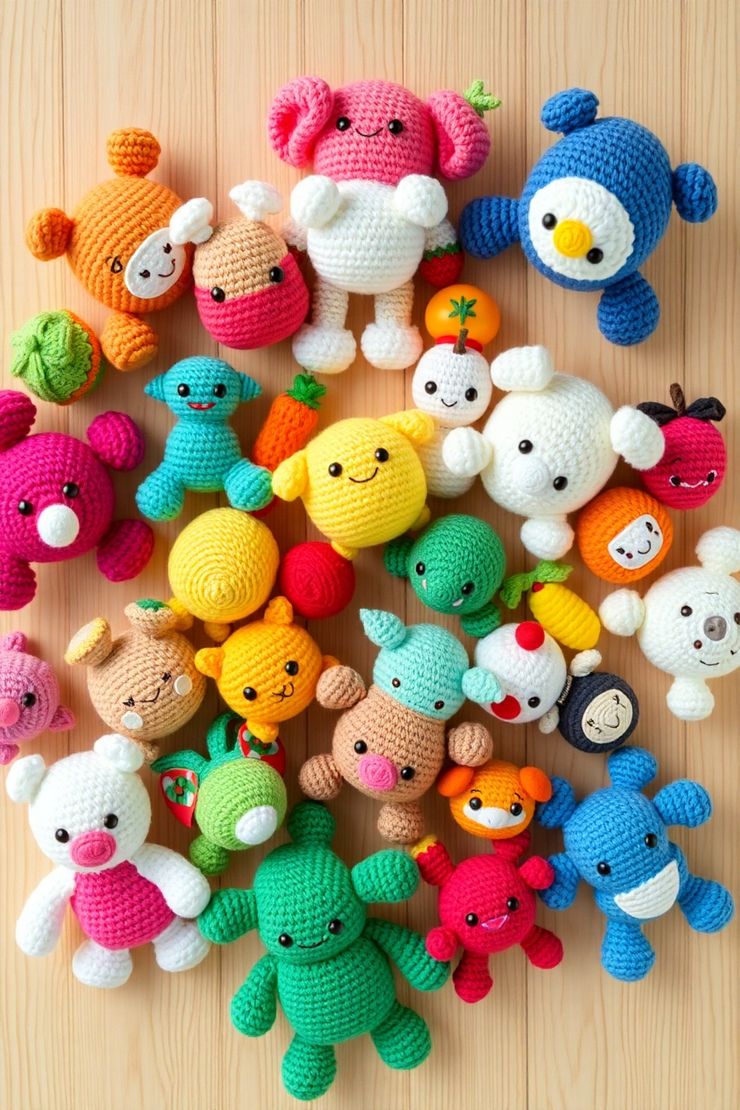Amigurumi
In the delightful intersection of
yarn art and adorable aesthetics lies the captivating world of
amigurumi. This Japanese craft, whose name playfully combines
"ami" (crocheted or knitted) and "nuigurumi" (stuffed doll), has
blossomed into a global phenomenon, enchanting crafters of all
skill levels with its promise of creating charming,
three-dimensional characters and objects. More than just a
hobby, amigurumi is a journey into miniature worlds, a chance to
imbue simple stitches with personality, and a rewarding way to
craft unique, huggable companions.

A Stitch in Time: The
Origins and Evolution of Amigurumi
While the exact origins are
debated, the roots of creating small, stuffed yarn creatures
likely stretch back centuries, with early forms appearing in
various cultures. However, the modern iteration of amigurumi,
with its distinct emphasis on kawaii (cuteness) and often
anthropomorphic designs, truly took hold in Japan during the
latter half of the 20th century. Influenced by the burgeoning
culture of manga, anime, and video games, amigurumi evolved from
simple children's toys into a recognized art form, capturing the
hearts of adults and children alike.
The rise of the internet and
crafting communities further propelled amigurumi onto the global
stage. Online patterns, tutorials, and shared creations fostered
a vibrant international community of "amigurumists," eager to
share their adorable creations and learn new techniques. Today,
amigurumi stands as a testament to the enduring appeal of
handmade objects and the universal language of cuteness.
The Anatomy of Cuteness:
Essential Tools and Techniques

Embarking on the amigurumi
adventure requires a few key tools and a foundational
understanding of crochet:
- Yarn: The
heart of every amigurumi creation. While various yarn
weights and fibers can be used, acrylic and cotton yarns are
popular choices for their durability, stitch definition, and
wide range of colors. The yarn weight will dictate the size
of your finished piece and the corresponding hook size.
- Crochet Hook:
The magic wand that transforms yarn into stitches. The size
of the hook should be appropriately matched to the yarn
weight to create a tight, dense fabric that prevents
stuffing from showing through. Often, amigurumists will go
down a hook size from the yarn label recommendation to
achieve this tight gauge.
- Stuffing:
The very essence of a "nuigurumi." Polyester fiberfill is
the most common and readily available stuffing material,
providing a soft and washable filling. Alternatives like
yarn scraps can be used, but fiberfill often provides the
best shape and consistency.
- Tapestry Needle:
A blunt-tipped needle with a large eye, essential for
weaving in yarn ends securely and for sewing together the
various parts of your amigurumi.
- Scissors: A
sharp pair of scissors for trimming yarn ends.
- Stitch Markers:
Indispensable for keeping track of rounds, especially when
working in continuous spirals, a hallmark of amigurumi.
- Safety Eyes or
Embroidery Thread: The key to bringing your
amigurumi to life. Safety eyes are plastic eyes with a post
and washer that securely attach to the crocheted fabric. For
smaller projects or for safety reasons (especially for young
children), embroidered eyes using embroidery thread are a
charming alternative.
- Pins:
Helpful for temporarily holding pieces together before
sewing.
The core techniques of amigurumi
rely heavily on basic crochet stitches, primarily the
single crochet (sc) in US terms (or double crochet in
UK terms). Shaping is achieved through strategic
increases (inc), where you work two stitches into the
same stitch, and decreases (dec), where you
join two stitches together to reduce the stitch count. Working
in a magic ring (or magic circle) is the
standard way to begin most amigurumi pieces worked in the round,
creating a tight, closed center.
Building Character,
Stitch by Stitch: The Creative Process
The true joy of amigurumi lies
in the creative process of bringing a character or object to
life stitch by stitch. Patterns serve as blueprints, guiding you
through the creation of individual components – the head, body,
limbs, and other features. Each piece is typically crocheted in
the round, creating seamless, three-dimensional shapes.
Once the individual parts are
complete, the real magic happens during assembly. Sewing the
pieces together requires patience and attention to detail to
ensure a securely attached and aesthetically pleasing result.
This is where the character truly begins to emerge.
Finally, adding the features –
the eyes, nose, mouth, and any other embellishments – injects
personality and charm into your creation. Whether using safety
eyes for a classic look or embroidering delicate features, this
stage is crucial for giving your amigurumi its unique
expression.
Beyond the Basics:
Exploring the Amigurumi Universe

The world of amigurumi extends
far beyond simple spheres and cylinders. As your skills develop,
you can explore a vast universe of patterns and techniques:
- Complex Shaping:
Utilizing various increase and decrease techniques to create
more intricate curves and contours.
- Colorwork:
Incorporating different yarn colors to create stripes,
spots, and other decorative elements.
- Textured Stitches:
Experimenting with different crochet stitches to add surface
texture to your amigurumi.
- Adding Details:
Incorporating elements like felt, buttons, beads, and even
wire armatures for poseability.
- Designing Your Own
Patterns: The ultimate step in the amigurumi
journey is creating your own unique characters and objects,
translating your imagination into yarn form.
The Enduring Appeal: Why
Amigurumi Captivates Hearts
In a world often dominated by
mass-produced items, amigurumi offers a tangible connection to
the joy of handmade creation. Each finished piece is a unique
testament to the crafter's time, effort, and imagination. The
inherent cuteness of these little yarn creatures evokes a sense
of warmth and playfulness, making them cherished gifts,
comforting companions, and delightful additions to any
collection.
More than just a craft,
amigurumi fosters a sense of community and connection among its
enthusiasts. Sharing patterns, showcasing creations, and
offering support within online and local crafting groups creates
a welcoming and inspiring environment.
Whether you are drawn to the
mindful rhythm of crochet, the satisfaction of bringing a
character to life, or the sheer adorableness of the finished
product, the enchanting world of amigurumi offers a rewarding
and endlessly creative journey. So, grab your hook and yarn, and
prepare to stitch your way into a world of cuddly companions and
boundless imagination. The adventure awaits, one adorable stitch
at a time.
|